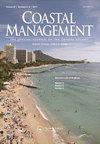A Multicriteria Assessment of Vulnerability to Extreme Rainfall Events on the Pacific Coast of Mexico
IF 1.9
4区 环境科学与生态学
Q4 ENVIRONMENTAL SCIENCES
引用次数: 2
Abstract
Abstract The likely increase in extreme rainfall events (ERE) due to climate change, particularly associated with tropical storms and hurricanes, threatens coastal communities worldwide. A model based on socioeconomic and environmental indicators was used to assess and categorize vulnerability to ERE at the municipal level, in Sinaloa, a coastal state of northwest Mexico. Coastal vulnerability was assessed based on a system of indicators, integrated into five criteria within two higher categories: response capacity (Economic conditions, Social development, and Living standards), and severity (Geographic exposure and Risk intensifiers). From a preliminary set of 25 indicators, three of them were selected by criterion using the Delphi method, and their values were later standardized from 0 (low) to 1 (high) on a vulnerability scale. Both criteria and indicators were weighted following an analytical hierarchical process (AHP), resulting in the main determinants of vulnerability being Geographic exposure (0.43) and Economic conditions (0.34). This first approach to a vulnerability assessment using standardized values showed that Guasave (to the north) and Escuinapa (to the south) are the most vulnerable municipalities, scoring >9.0 (with 15 being the maximum score). In contrast, Culiacán and San Ignacio, both central municipalities, ranked as the least vulnerable (<5.5). A further analysis using the integral vulnerability index (IVI) corroborated Guasave (3.73) and Escuinapa (3.15) as the most vulnerable, discarding latitudinal changes as a possible promotor of vulnerability. Although the coastal population was the main determinant of vulnerability (median = 0.57), other indicators associated with severity as well as response capacity were responsible for the increase in IVI scores. This study highlights the need for an integrated vulnerability analysis to support public policies and the decision-making process to protect coastal communities from environmental climate change.墨西哥太平洋海岸极端降雨事件脆弱性的多标准评估
由于气候变化,特别是与热带风暴和飓风相关的极端降雨事件(ERE)可能增加,威胁着全球沿海社区。在墨西哥西北部沿海州锡那罗亚州,采用基于社会经济和环境指标的模型对城市一级的ERE脆弱性进行评估和分类。沿海脆弱性的评估基于一套指标体系,并将其纳入两个更高类别的五个标准:响应能力(经济条件、社会发展和生活水平)和严重程度(地理暴露和风险加剧因素)。从初步确定的25个指标中,采用德尔菲法对其中的3个指标进行标准选择,并将其脆弱性等级从0(低)到1(高)进行标准化。根据层次分析法(AHP)对标准和指标进行加权,得出脆弱性的主要决定因素是地理暴露(0.43)和经济条件(0.34)。使用标准化值进行脆弱性评估的第一种方法显示,瓜萨夫(北部)和埃斯奎纳帕(南部)是最脆弱的城市,得分为>9.0(最高得分为15分)。相比之下,中部城市Culiacán和圣伊格纳西奥被评为最不脆弱的城市(<5.5)。利用积分脆弱性指数(IVI)进一步分析,Guasave(3.73)和Escuinapa(3.15)是最脆弱的,排除了纬度变化可能是脆弱性的促进因素。虽然沿海人口是脆弱性的主要决定因素(中位数= 0.57),但与严重程度和响应能力相关的其他指标是导致IVI得分增加的原因。本研究强调需要进行综合脆弱性分析,以支持公共政策和决策过程,以保护沿海社区免受环境气候变化的影响。
本文章由计算机程序翻译,如有差异,请以英文原文为准。
求助全文
约1分钟内获得全文
求助全文
来源期刊

Coastal Management
环境科学-环境科学
CiteScore
6.00
自引率
0.00%
发文量
24
审稿时长
>36 weeks
期刊介绍:
Coastal Management is an international peer-reviewed, applied research journal dedicated to exploring the technical, applied ecological, legal, political, social, and policy issues relating to the use of coastal and ocean resources and environments on a global scale. The journal presents timely information on management tools and techniques as well as recent findings from research and analysis that bear directly on management and policy. Findings must be grounded in the current peer reviewed literature and relevant studies. Articles must contain a clear and relevant management component. Preference is given to studies of interest to an international readership, but case studies are accepted if conclusions are derived from acceptable evaluative methods, reference to comparable cases, and related to peer reviewed studies.
 求助内容:
求助内容: 应助结果提醒方式:
应助结果提醒方式:


